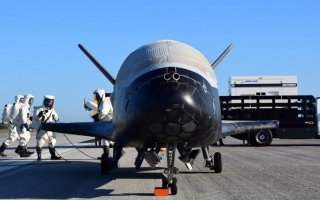What Is This?: Is the X-37B Space Drone a Weapon or Experiment?
The X-37B is the first vehicle since NASA’s Shuttle Orbiter with an ability to return experiments to Earth for further inspection and analysis, a Pentagon paper explains.
Here's What You Need to Know: New technologies are being tested and refined. But for what reason?
Just what is the mission intent and concept of operation for the U.S. Space Force’s experimental X-37B Orbital Test Vehicle drone? Is it an anti-satellite space attack plane? Can it attack missiles or track enemy weapons? Such questions abound as the Boeing-built space drone enters new phases of technological maturity and nears operational status. The X-37B is the first vehicle since NASA’s Shuttle Orbiter with an ability to return experiments to Earth for further inspection and analysis, a Pentagon paper explains.
“Upon command from the ground, the OTV autonomously re-enters the atmosphere, descends and lands horizontally on a runway,” an Air Force Statement says.
The Air Force report goes on to say that the technologies being tested in the program include advanced guidance, navigation and control, thermal protection systems, avionics, high temperature structures and seals, conformal reusable insulation, lightweight electromechanical flight systems, advanced propulsion systems, advanced materials and autonomous orbital flight, reentry and landing.
The technologies cited by the Air Force as under examination raise some interesting and substantial questions, several of which pertain to the ability to conduct operations at extremely high speeds and therefore high temperatures. “Thermal protection” is essential for space flight in several key respects, as it is necessary to ensure a stable flight trajectory for space-travelling weapons such as intercontinental ballistic missiles or hypersonic missiles. Moreover, thermal protections or insulating technology of some kind is precisely the kind of technology needed to enable humans to travel through space. This raises the possibility that, at some unknown point in the future, armed, manned high-speed spacecraft may well launch attacks from beyond the boundaries of the earth’s atmosphere.
Secondly, “advanced materials” are essential to successful space operation as they are what’s needed to engineer structures, components and propulsion systems durable enough to survive the temperatures and atmospheric rigors of space travel. Materials of this kind are already maturing quickly as they are fundamental to the operational deployment of hypersonic weapons. Not only are they necessary to sustain flight stability at hypersonic speeds, but they are needed to ensure the structural configurations needed to generate the proper air flow boundary layer surrounding missiles, interceptors or spacecraft.
Space autonomy is also of great significance, as advanced algorithms enabling autonomous space flight are progressing at lightning speed, creating a circumstance wherein unmanned systems could conduct surveillance missions, reinforce or expand satellite communications networks or even fire weapons when directed by humans operating in a command and control capacity.
NASA’s original X-37 program began in 1999 and was transferred to DARPA in 2004.
Kris Osborn is the new Defense Editor for the National Interest. Osborn previously served at the Pentagon as a Highly Qualified Expert with the Office of the Assistant Secretary of the Army—Acquisition, Logistics & Technology. Osborn has also worked as an anchor and on-air military specialist at national TV networks. He has appeared as a guest military expert on Fox News, MSNBC, The Military Channel, and The History Channel. He also has a Masters Degree in Comparative Literature from Columbia University.
This article first appeared earlier this year.
Image: Reuters

